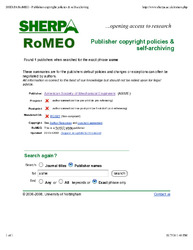| dc.contributor.author | Kandlikar, Satish | |
| dc.contributor.author | Spiesman, Paul | |
| dc.date.accessioned | 2008-11-14T18:06:31Z | |
| dc.date.available | 2008-11-14T18:06:31Z | |
| dc.date.issued | 1998-11 | |
| dc.identifier.uri | http://hdl.handle.net/1850/7495 | |
| dc.description | Paper presented at the ASME IMECE98 meeting, November 15-20, 1998. Please go to www.asme.org for the complete paper. | en_US |
| dc.description | RIT community members may access full-text via RIT Libraries licensed databases: http://library.rit.edu/databases/ | |
| dc.description.abstract | It is well known that the surface structure affects the pool boiling
heat transfer from a heater surface. The number and size distribution
of cavities present on a heater surface affect the nucleation
characteristics. This fact is utilized in developing structured and
sintered surfaces for enhanced boiling performance. The nucleate
boiling component in flow boiling is also expected to exhibit a
somewhat similar dependence.
The present study investigates the flow boiling heat transfer of
subcooled water over heater surfaces prepared with different roughness
characteristics. The setup consists of a 9.5 mm diameter circular heater
placed on the lower wall of a 3 mm x 40 mm horizontal channel. Four
different surface finishes are tested on the same heater unit. Each
surface is observed under a microscope, and analyzed with an image
processing software to obtain the cavity size distribution.
Relationships between the cavity size distribution and the heat transfer
are then compared for the four surfaces.
The results indicate that the wall superheats for the four surfaces
tested were within 0-30 percent of each other for a given heat flux.
Although the roughest surface generally performed the best, no definite
trend could be observed. It is also noted that the cavity size
distribution of a surface is not significantly affected by simple
polishing techniques. A commercially prepared sintered surface is also
tested. Its performance was markedly above the four roughened
surfaces. However, the sintered surface exhibited a large hysteresis
effect, while the four roughened surfaces showed little hysteresis under
the test conditions. | en_US |
| dc.language.iso | en_US | en_US |
| dc.publisher | American Society of Mechanical Engineers (ASME) | en_US |
| dc.relation | RIT Scholars content from RIT Digital Media Library has moved from http://ritdml.rit.edu/handle/1850/7495 to RIT Scholar Works http://scholarworks.rit.edu/other/365, please update your feeds & links! | |
| dc.title | Effect of surface finish on flow boiling heat transfer | en_US |
| dc.type | Proceedings | en_US |

